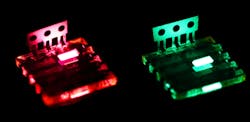LEDs made from perovskite could enable low-cost LED displays
Researchers from the University of Cambridge (Cambridge, England), Ludwig-Maximilians-Universität München (München, Germany), and the University of Oxford (Oxford, England) have created high-brightness LEDs based on a hybrid form of perovskite.1 The LEDs emit in either the near-infrared, green, or red; the prototypes' external and internal quantum efficiencies are 0.76% and 3.4% respectively for near-IR, and 0.1% and 0.4% for green.
Because the quantum efficiencies of the LEDs increase at higher current densities, the researchers are optimistic about developing high-efficiency perovskite LEDs at low cost that could be incorporated into displays and lighting, as well as optical-communications devices.
Perovskite is a general term used to describe a group of materials that have a distinctive crystal structure of cuboid and diamond shapes. They have long been of interest for their superconducting and ferroelectric properties. But in the past several years, their efficiency at converting light into electrical energy has drawn much interest from photovoltaic-cell researchers.
The perovskites that were used to make the LEDs are known as organometal halide perovskites, and contain a mixture of lead, carbon-based ions, and halides. These materials dissolve well in common solvents and assemble to form perovskite crystals when dried, making them cheap and simple to make.
"These organometal halide perovskites are remarkable semiconductors," says Zhi-Kuang Tan, a PhD student at the University of Cambridge's Cavendish Laboratory and the paper's lead author. "We have designed the diode structure to confine electrical charges into a very thin layer of the perovskite, which sets up conditions for the electron-hole capture process to produce light emission."
Made by spin-coating
To make the perovskite LEDs, a perovskite solution is prepared and simply spin-coated onto a substrate.
"The big surprise to the semiconductor community is to find that such simple process methods still produce very clean semiconductor properties, without the need for the complex purification procedures required for traditional semiconductors such as silicon," says professor Sir Richard Friend of the Cavendish Laboratory.
The team is now looking to increase the efficiency of the LEDs and to use them as laser diodes. The first commercially-available LED based on perovskite could be available within five years.
Source: http://www.cam.ac.uk/research/news/leds-made-from-wonder-material-perovskite
REFERENCE:
1. Zhi-Kuang Tan et al., Nature Nanotechnology (2014); doi: 10.1038/nnano.2014.149
About the Author
John Wallace
Senior Technical Editor (1998-2022)
John Wallace was with Laser Focus World for nearly 25 years, retiring in late June 2022. He obtained a bachelor's degree in mechanical engineering and physics at Rutgers University and a master's in optical engineering at the University of Rochester. Before becoming an editor, John worked as an engineer at RCA, Exxon, Eastman Kodak, and GCA Corporation.

